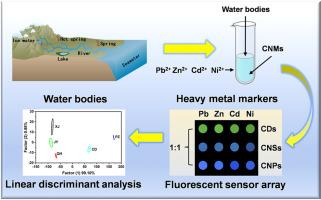重金属标记物扩增识别分析:利用碳纳米材料荧光和机器学习增强水体分化
IF 6
2区 化学
Q1 CHEMISTRY, ANALYTICAL
引用次数: 0
摘要
传统的水资源监测方法通常是多要素跟踪,依赖多维数据降维,但主要侧重于水资源信息评估和时空变化,无法有效区分区域水体。区分区域水体对可持续资源管理至关重要。因此,建立快速高效的水体识别分析新策略具有重要意义。结果本研究基于碳纳米材料(CDs、CNSs、CNPs)和机器学习,开发了一种新型荧光传感器阵列,用于区域水体的有效区分,并在其上添加了重金属标记物。为了放大识别分析,提出了重金属标记的概念,即设计了一个由Pb2+、Zn2+、Cd2+和Ni2+组成的重金属标记系统作为信号放大器,通过纳米材料与样品基质之间的竞争性结合相互作用,显著放大了荧光差异。通过结合线性判别分析(LDA),该系统在相邻水体和跨区域水体的Wilks’Lambda值接近于零的情况下实现了100%的分类准确率。该传感器具有出色的抗干扰能力,可准确区分高盐度和受污染的水源。同时,该方法在水源识别方面具有较高的空间分辨率,可以分辨距离为2 km的相邻水源。以Pb2+、Zn2+、Cd2+、Ni2+组合重金属标记物为例,验证了重金属标记物的概念,证明了添加标记物是达到最佳识别目标的有效途径。这种方法可能为污染源追踪提供可靠的工具,显示出未来环境监测应用的巨大潜力。本文章由计算机程序翻译,如有差异,请以英文原文为准。

Heavy metal marker-amplified recognition analysis: enhanced water body differentiation via carbon nanomaterial fluorescence and machine learning
Background
Traditional water monitoring methods usually track multiple elements and rely on multi-dimensional data for dimensionality reduction, but they primarily focus on assessing water resource information and spatiotemporal changes rather than effectively distinguished between regional water bodies. Distinguishing regional water bodies is essential for sustainable resource management. Therefore, it is important to establish new strategy for fast and efficient recognition analysis of water bodies.Result
This study develops a novel fluorescent sensor array based on carbon nanomaterials (CDs, CNSs, CNPs) and machine learning for efficient differentiation of regional water bodies, to which heavy metal markers was added. The concept of heavy metal marker was proposed to amplify the recognition analysis, i.e., a heavy metal marker system comprising of Pb2+, Zn2+, Cd2+ and Ni2+ was engineered as signal amplifiers, markedly amplifying fluorescence disparities through competitive binding interaction between the nanomaterials and sample matrices. By combining linear discriminant analysis (LDA), the system achieved 100% classification accuracy validated by near-zero Wilks' Lambda values for both adjacent water bodies and cross-regional counterparts. The sensor exhibits exceptional anti-interference capability, accurately differentiating high-salinity and polluted water sources. Simultaneously, it can achieve high spatial resolution in water source discrimination, resolving adjacent sources separated by <2 km.Significance
As a proof of concept of heavy metal marker with a combination of Pb2+, Zn2+, Cd2+, and Ni2+ as an example, it was proved that adding the markers is an efficient way to achieve the best discrimination goal. This approach may provide a reliable tool for pollution source tracing, demonstrating significant potential for environmental monitoring applications in the future.求助全文
通过发布文献求助,成功后即可免费获取论文全文。
去求助
来源期刊

Analytica Chimica Acta
化学-分析化学
CiteScore
10.40
自引率
6.50%
发文量
1081
审稿时长
38 days
期刊介绍:
Analytica Chimica Acta has an open access mirror journal Analytica Chimica Acta: X, sharing the same aims and scope, editorial team, submission system and rigorous peer review.
Analytica Chimica Acta provides a forum for the rapid publication of original research, and critical, comprehensive reviews dealing with all aspects of fundamental and applied modern analytical chemistry. The journal welcomes the submission of research papers which report studies concerning the development of new and significant analytical methodologies. In determining the suitability of submitted articles for publication, particular scrutiny will be placed on the degree of novelty and impact of the research and the extent to which it adds to the existing body of knowledge in analytical chemistry.
 求助内容:
求助内容: 应助结果提醒方式:
应助结果提醒方式:


